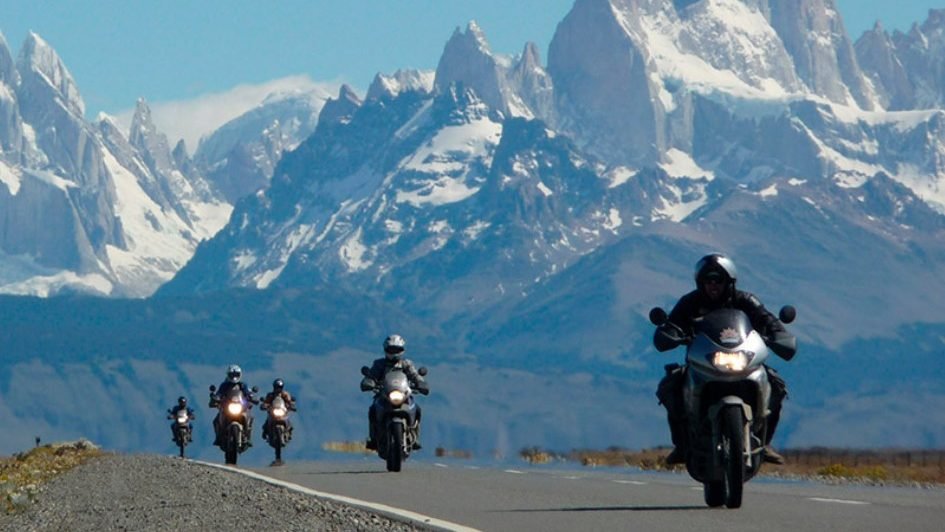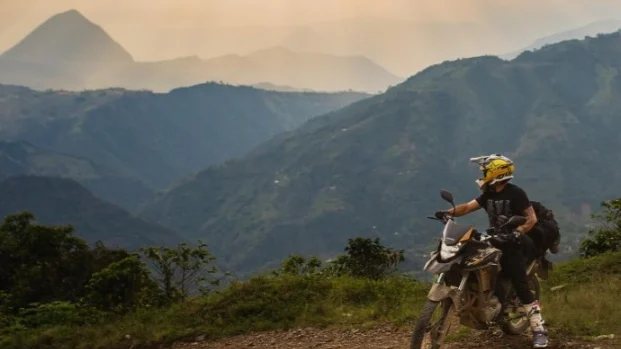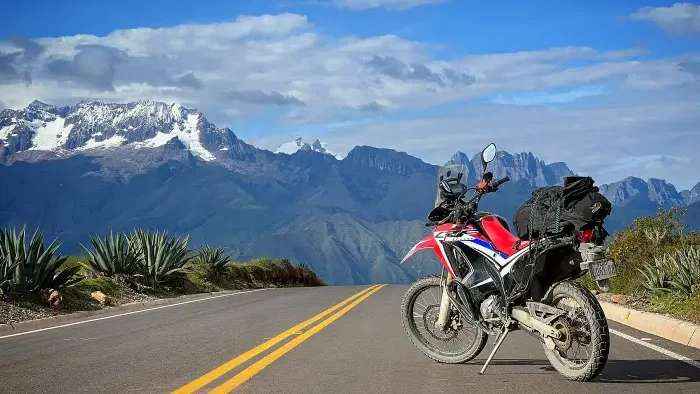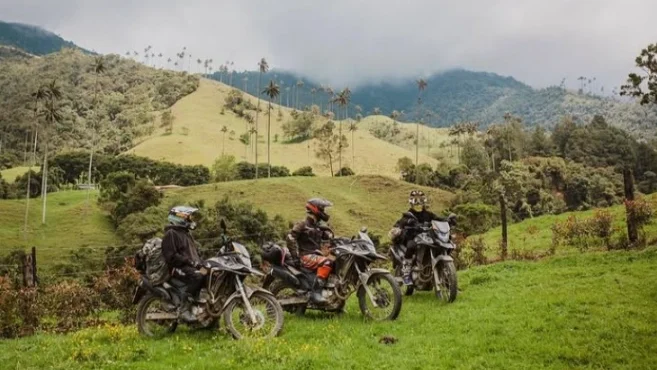
South America – just the name alone conjures images of rugged mountain roads, lush Amazon jungle tracks, and endless open pampas where a motorcycle can howl to the horizon. For adventure riders, South America is a continent of superlatives: the longest mountain range in the world, some of the highest rideable passes on Earth, vast deserts, tropical rainforests, and cultures as rich and diverse as the landscapes. If you’ve ever dreamed of leaning into the curves of the Andes or thundering down remote Patagonian roads, this guide is for you. We’ll explore the ins-and-outs of motorcycle touring in South America, highlight a few must-ride routes and destinations, and offer tips to make your South American moto-adventure one for the books. ¡Vamos! Let’s ride through the essentials of a South American tour.
What makes South America such a magnet for motorcycle adventurers? First, the geography is simply awe-inspiring. The Andes, stretching over ~7,000 km from Colombia to Chile, form the backbone of the continent. These mountains offer passes reaching well over 4,000 m in elevation, with the highest peaks like Aconcagua soaring to 6,960 m (that one you can’t ride over, but you sure can ride to its base). Riding in the Andes means tackling roads that zigzag up cloud-topping summits and descend into verdant valleys. It’s where you can find the world’s highest border crossing between Argentina and Chile (Abra del Acay in Argentina, nearly 4,972 m high) and countless smaller passes that are an absolute playground for adventure bikes.
Then there’s the sheer variety of landscapes. In one trip you could go from the equatorial tropics of Ecuador’s jungles, to the high-altitude plains of Bolivia (the Altiplano), down to the arid dunes of Chile’s Atacama Desert (driest desert on Earth), and further to the icy glaciers and windswept plains of Patagonia at the continent’s southern tip. South America has safari-like grasslands too – the Llanos in Venezuela or the Pampas in Argentina – where gauchos (cowboys) roam. And let’s not forget coastal rides: imagine tracing the Pacific coast in Peru, where desert meets ocean, or cruising Brazil’s Atlantic coastline with palm-lined beaches to one side and rainforest mountains to the other.
Beyond nature, South America’s cultural tapestry adds another layer to any tour. You pass through Quechua and Aymara indigenous villages in the Andes where women in bright dresses herd llamas. You can visit colonial towns where Spanish architecture and cobblestone roads take you back in time. Perhaps you’ll time your ride to see a local festival – maybe stumbling upon a spontaneous street tango in Argentina or an Andean carnival in Peru. Each country has its own flavor: the European flair of Argentina and Chile, the indigenous heartbeat of Bolivia and Peru, the Afro-Latin rhythms of Colombia’s Caribbean coast, and so on. Every border you cross on two wheels isn’t just a line on a map – it’s a new adventure in food, music, language (get that Spanish polished up!), and hospitality.
Finally, the sense of accomplishment. South America is vast. Completing a long route here – whether it’s a loop through the Andean nations or the famous Pan-American Highway from Colombia all the way to Ushuaia – is a feat riders wear like a badge of honor. Speaking of which, Ushuaia in Argentina is the southernmost city in the world accessible by road, often seen as the “finish line” for trans-continental riders. The Pan-American Highway stretches roughly 30,000 km from Alaska down to Argentina (with a break at the Darién Gap between Panama and Colombia). Riding its South American portion or any significant chunk of it is a life-changing experience for many. When you tour here, you’re not just sightseeing – you’re living an adventure that tests you and rewards you every day.
? Discover South America’s Motorcycle Adventures on Throttle Trails

South America is huge, so let’s break down some standout routes and areas that are particularly popular (and deservedly so) among motorcycle travelers:
Highlights: The Andes Mountains are the spine of South America and home to countless epic rides. In Peru, one unmissable route is the ride from Cusco to Machu Picchu (well, as close as you can get by road to Machu Picchu, typically to the town of Santa Teresa). Winding mountain roads, cloud forest humidity, and the sense of history pervade this ride. Another gem is the Peruvian Andes route north of Lima: the Cordillera Blanca region near Huascarán National Park. There’s a road called the Canon del Pato (Duck Canyon) with 40+ one-lane tunnels carved into cliff walls – talk about a thrilling ride as you dodge oncoming trucks in those tunnels! Peru offers a mix of paved and unpaved adventures; one minute you’re on the Pan-American coastal highway, the next you’re climbing switchbacks to a 4,800 m pass with alpacas as spectators.
Jump over to Bolivia, and you’ve likely heard of the North Yungas Road, aka “Death Road,” near La Paz. It’s infamous and a bit touristy nowadays (mostly mountain bikers coasting down it), but riding it on a motorcycle is still a feather in the cap. This narrow dirt road clinging to a cliff has seen its share of fatalities – around 200-300 per year in its heyday – but since the main traffic has moved to a new road, it’s relatively safer for recreation now. Still, the sheer drop-offs and breathtaking views make it unforgettable. Beyond Death Road, Bolivia offers the Salar de Uyuni, the world’s largest salt flat. Imagine riding on a blindingly white, perfectly flat expanse stretching to the horizon – it’s surreal. Just don’t try it in the wet season unless you want to corrode every metal part of your bike with salt! When dry, you can ride out to the famous salt hotel or the “islands” of cacti in the middle of the salar. Bolivia’s altiplano routes, like the Lagunas Route in the southwest (with colorful high-altitude lagoons and volcanoes) are pure adventure but require a capable dual-sport and some experience – it’s remote and tough out there.
Heading north, Ecuador might be smaller but it’s a treasure trove: In a single day you can ride from the Andes to the Amazon basin or to the Pacific Coast. The Avenue of the Volcanos (Pan-American Highway through central Ecuador) gives you views of towering peaks like Cotopaxi and Chimborazo as you ride good tarmac through high valleys. But venture off the main road and you can find cloud forest dirt tracks or twisties that go up into indigenous villages where time stands still. Ecuador is a bit of a hidden gem for riders – relatively short distances, great scenery, and friendly folks. Plus, you can cross the equator line on your bike (there’s a monument and everything at Mitad del Mundo near Quito, albeit that one’s more a tourist stop).
And in Colombia, the Andes split into three branches, creating an array of mountain roads with more curves than you can imagine. The ride from Medellín to Bogotá, for instance, takes you through the Magdalena River Valley and then up into chilly mountains – you’ll experience heat, rain, and fog all in one day. Don’t miss the Alto de Letras, one of the longest continuous climbs in the world – beloved by cyclists and a worthy challenge for motorcyclists – it climbs about 3,700 m (12,000+ ft) from base to summit! Colombia’s Andes are lush and green, with coffee plantations on the hillsides. Stopping in a small town for a “tinto” (local coffee) after a crazy set of hairpins is heaven. And the landscapes – wax palm tree forests in the Cocora Valley, for example – are unlike anywhere else.

Highlights: If the tropics aren’t your thing and you prefer wide open spaces and cooler climes, Patagonia will steal your heart. This region at the southern end of South America spans both Chile and Argentina. Think sweeping steppe plains, snow-capped mountains, turquoise glacier-fed lakes, and fierce winds that can knock you sideways (no joke – Patagonia’s winds are legendary, so hold onto those handlebars).
One of the ultimate rides here is the Carretera Austral (Chile’s Route 7). This partially unpaved road runs about 1,200 km through Chilean Patagonia from Puerto Montt down to Villa O’Higgins. Along the way you pass jagged peaks, hanging glaciers (check out the Queulat Hanging Glacier – a short hike from the road rewards you with a view of a glacier spilling over a cliff, melting into a waterfall), and dense forests. The Carretera Austral is often a mix of gravel and improved dirt, with some pavement creeping in each year. It’s remote – you’ll take a couple of ferries as it hops fjords, and towns are few and far between. But oh boy, is it beautiful. Picture riding on a winding gravel path with a massive blue glacier to your left and a shimmering fjord to your right. It’s adventure bliss.
On the Argentine side, you have Ruta 40, which runs the length of Argentina north-south (over 5,000 km). The southern portion of Ruta 40 in Patagonia is a favorite – long stretches of lonely asphalt and gravel through arid plains with the Andes off to the west. Key stops include the town of El Calafate (base for visiting the Perito Moreno Glacier – you can’t ride to the glacier, but you park and walk, and trust me it’s worth it to see a 70m tall ice wall crashing into the water) and the hamlet of El Chaltén, Argentina’s trekking capital, where Mount Fitz Roy looms sharp and dramatic. Motorcycle riders often aim for Ushuaia, as mentioned, which you reach via Tierra del Fuego – an island shared by Chile and Argentina at the very bottom. Getting to Ushuaia means you’ve literally ridden to the “End of the World” (well, the end of the road at least). Take a photo by the sign in Ushuaia that proclaims it the fin del mundo. Then go have some king crab at a local eatery to celebrate.
Another unmissable route is the road to Torres del Paine National Park in Chile. The park is an icon, with its trio of granite towers and herds of guanacos roaming the plains. The approach roads from Puerto Natales feature fantastic views of the massif. They’re mostly gravel, often washboard rough, but absolutely stunning under Patagonia’s ever-changing skies.
Keep in mind Patagonia is all about timing – the summer (December to February) is the main window for riding. Outside of that, it can be brutally cold, wet, or snowy. Even in midsummer, you can experience four seasons in a day here.
? Discover South America’s Motorcycle Adventures on Throttle Trails
Highlights: South America isn’t just mountains and pampas; it also offers unique coastal and jungle rides.
On the Pacific Coast, you have the Pan-American Highway running from Chile up through Peru and Ecuador. Some stretches might seem barren (like northern Peru’s Sechura Desert, which is a surreal dunes-meet-ocean landscape). But riding Peru’s coastal Pan-Am also takes you near fabulous sites like the Nazca Lines (you can’t see the giant ancient geoglyphs from the ground, but you can stop and take a short flight tour if you want). Further north, around Trujillo, Peru, you can detour to see the Chan Chan ruins or take a break on the beach at Huanchaco watching reed fishing boats. In Chile, the Pan-Am (Route 5 there) is well-paved and efficient, passing through the Atacama where it basically doesn’t rain… ever. Stopping in San Pedro de Atacama lets you venture into the desert’s moonscape valleys or gaze at unbelievably clear stars at night.
Over on the Atlantic side, Brazil offers a mix of experiences. Brazil’s coastal roads near Rio de Janeiro and São Paulo are quite stunning – picture curving roads through Atlantic rainforest with ocean views popping out at every other bend. The Serra do Mar mountain range runs parallel to the coast, so you get fun twisty climbs and descents (like the famous Serra do Rio do Rastro road in Santa Catarina – full of switchbacks and amazing views). Further north, coastal Northeast Brazil has its own vibe – you can even ride on some beaches when the tide’s out (with caution). Brazil’s interior has the Amazon, of course, but true Amazon jungle riding is an expedition – roads like the BR-319 from Manaus to Porto Velho are red mud madness in the wet season and remote as it gets. Not for the faint of heart, but the bragging rights are huge if you do tackle an Amazon road. You might consider more accessible jungle roads like those in Peru’s Amazon basin or Bolivia’s lowlands if you want that lush, steamy forest feel without quite as much peril.
One particularly famed route is Peru’s Transoceanic Highway (also called Interoceanic), which runs from the Peruvian coast over the Andes and down into Brazil. It’s now fully paved and offers an insane variety in one go – starting maybe in Cusco, Peru (Andean highlands), you climb over 4,700 m passes, then descend into the Madre de Dios rainforest, ending up in Brazil’s Acre state. It’s literally ocean to ocean (well, almost – technically you’d have to continue to the Brazilian Atlantic coast to complete that, but you get the idea). This route is important because it opened up a lot of new riding possibilities – though watch out, the jungle section is very hot and humid, and you’ll want to plan fuel stops carefully.

South America boasts some record-setting roads. If you’re a pass-hunter or a thrill-seeker, consider these:
? Discover South America’s Motorcycle Adventures on Throttle Trails
Embarking on a South American journey requires some preparation. Here are key tips and insights to help:
1. Plan for Border Crossings and Documents: If you’re crossing multiple countries (likely, since the best routes often weave through several), ensure your paperwork is in order. You’ll need a valid passport, of course, and for the bike, a Temporary Import Permit (TIP) at each border. The process is usually straightforward: you get an import permit for your motorcycle that allows you to bring it into the country for a set period (usually a few months). Keep your bike title/registration and insurance papers handy; some countries require proof of insurance for entry (Argentina and Chile often do). There’s also the Carnet de Passages alternative for some travelers, but in South America, most countries do not require a carnet (exceptions being Brazil used to, but not anymore for most, and not at all for the rest). Always double-check current regulations, though – things can change.
2. Fuel Quality and Availability: In the Andes and Patagonia, fuel stations can be hundreds of kilometers apart, as mentioned. In places like Bolivia, expect lower-octane fuel (sometimes 84 or so). Many modern adventure bikes can handle it, but if yours is finicky, consider an octane booster additive. Also, Bolivia has a strange policy where officially fuel for foreigners is more expensive – sometimes gas station attendants don’t want to bother with the paperwork for that, so they might refuse or ask you to find someone local to fill your tank. A workaround many use is to carry a small jerry can and have locals fill that, then pour into your bike. In remote areas, you’ll find “fuel” sold in reused plastic bottles by roadside vendors – it’s expensive and quality varies, but it could get you to the next real station in a pinch.
3. Altitude and Health: If your route hits high altitudes (pretty likely in the Andes), be mindful of altitude sickness. Symptoms include headache, nausea, dizziness. Acclimatize gradually if you can: for instance, after riding up to a high city like La Paz (3,600 m) or Cusco (3,400 m), take a day off to rest. Stay hydrated and avoid heavy drinking – alcohol hits harder up high. Locals swear by coca tea or chewing coca leaves; it can help some with symptoms (and it’s legal in Andean countries to consume coca in that traditional manner, just don’t try to carry any across borders or back home). For your bike: expect roughly 20% power loss at extreme heights, and possibly some rough running if carbureted unless re-jetted. Fuel injection usually adjusts, but might still feel a bit sluggish.
4. Safety and Security: People often ask, “Is it safe?” Overall, yes – millions of friendly folks live here and will greet you warmly. But petty theft can be an issue in certain areas, so use common sense. In big cities, use secure parking (many hotels have or can arrange it). Use a good lock on your bike when parked overnight or in public. Don’t flash expensive gadgets in poorer areas. Political protests (which can involve road blockades) happen occasionally – if you encounter one, stay patient, polite, and find a way around if possible. And always obey local traffic laws (or at least, don’t do anything crazier than the locals). In some countries, traffic can be chaotic; just ride alert and defensive. One nice thing: many South American drivers are used to motorcycles filtering and passing – just don’t be reckless and they usually won’t mind you slipping through.
5. Weather Timing: As touched on, the timing of your trip matters. The equator runs through Ecuador – north of it, seasons are flipped (Colombia/Venezuela have rainy vs dry seasons but are always warm; further north in hemisphere doesn’t apply here). South of the equator, seasons are opposite of North America/Europe. So if it’s summer up there, it’s winter in, say, Chile/Argentina. You don’t want to hit Patagonia in July (dead of winter) unless you like snow and closed mountain passes. Conversely, trying the Bolivian salt flats in January might leave you floating in a lake (rainy season floods the Uyuni flats). Research each region’s best riding season: e.g., Patagonia (Dec-Feb), Andes in Peru/Bolivia (May-September is drier and ideal), Amazon (drier season for dirt roads is better, though still muddy). If doing a multi-country tour, aim for a shoulder season that works “okay” for all rather than perfect for one and awful for another.
6. Embrace the Adventure Attitude: South America will test your adaptability. Plans might change due to a landslide blocking a road, a festival closing a town, or you simply falling in love with a place and wanting to linger. Be flexible with your itinerary. It’s often said here, “No hay mal que por bien no venga” – roughly, every bad situation brings something good. A delay might lead you to meet great people or discover a hidden gem. Also, pick up some Spanish phrases; even basic language skills will hugely enrich your interactions. Locals are usually thrilled and supportive to see foreigners exploring their country on a motorcycle – it’s somewhat unusual and they’ll treat you like a heroic traveler (sometimes you get waves, thumbs up, even random invitations or offers of help).
? Discover South America’s Motorcycle Adventures on Throttle Trails

It’s tough to narrow down, but if I were crafting an ultimate South America motorcycle tour wishlist, I’d include at least these highlights:
? Discover South America’s Motorcycle Adventures on Throttle Trails
South America truly has it all for the adventurous motorcyclist. Whether you crave high-altitude drama, off-road grit, or cultural immersion (likely you want a taste of each), you’ll find a route here with your name on it.
So load up that bike, brush up on “hola, amigo”, and set your compass south. As they say in Latin America, “Buena ruta” – have a good road! South America’s waiting, with an endless supply of curves, vistas, and unforgettable moments for those bold enough to ride them.
If you’re feeling inspired to ride South America, don’t miss our curated Motorcycle Tours in South America on our site – from the Peruvian Andes to Colombia’s jungles, we’ve got guided trips that cover many of the highlights mentioned (and take care of logistics so you can just enjoy the ride). Interested in a specific country? Check out our destination pages like Peru Motorcycle Tours – Desert, Andes & Jungle or Colombia Motorcycle Adventures for detailed itineraries and options.
Get ready to conquer the open roads of the Andes and beyond – ¡Nos vemos en la carretera! (See you on the road!)
WhatsApp us